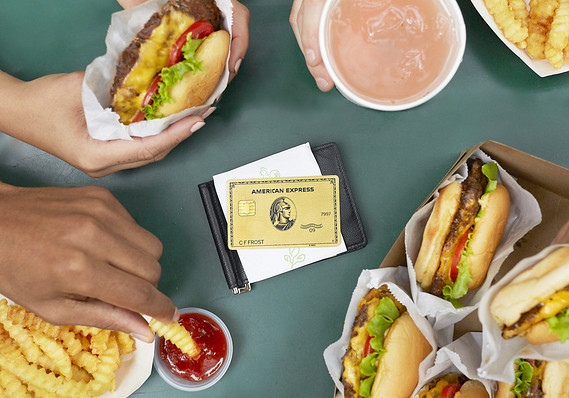Is the way to a consumer’s wallet through his stomach? American Express AXP, +1.41% is betting that the answer is yes.
Beginning this week, American Express will reward Gold Card holders with 4X points on purchases made at restaurants worldwide. Previously, the credit-card company only rewarded customers for spending money at restaurants in the U.S.
AmEx Gold Card customers can now use an annual $120 dining credit for the online wholesale retailer Boxed. The dining credit can also be used on purchases at Grubhub GRUB, +3.29% , Seamless, Shake Shack SHAK, +3.04% , The Cheesecake Factory CAKE, -0.58% , and Ruth’s Chris Steak House. RUTH, -0.30%
Half of Gold Card members who enrolled for the dining credit used a portion of their allotment on a monthly basis since the Gold Card was revamped last year.
The card’s other rewards categories — including 4x points at U.S. supermarkets and 3x points on flights booked directly with airlines or through AmEx’s travel portal — remain in place. The card’s annual fee remains $250, same as last year.
“Travel is pretty much always going to be the centerpiece for credit-card rewards, but there’s no question that issuers are really focusing a lot on dining,” said Matt Schulz, chief industry analyst at personal-finance website CompareCards TREE, +0.53% “It touches a lot of the same crowd. Chances are if you travel a lot, you probably eat out a fair amount, too.”
Travel-based rewards programs can be lucrative for consumers — but they’ve proven to be expensive for banks. Many consumers have learned how to game the system, namely by putting lots of money on cards to earn sign-up bonuses before paying off the balance and closing the card.
As a result, some banks have begun to pare back their rewards programs and have jettisoned popular travel-related perks, The Wall Street Journal reported earlier this year.
Don’t miss: Chase is bringing forced arbitration clauses back to its most popular credit cards
Is dining becoming the new travel for credit-card rewards?
The American Express Gold Card is not the only credit card to offer substantial rewards for dining.
The Citi Prestige card C, -1.17% comes with the best rewards rate for dining at 5x points per dollar spent, but the card carries a whopping $495 annual fee making it an option that generally makes sense only for wealthy credit-card users.
The Capital One Savor Rewards Card COF, -0.11% offers 4% cash back on dining and entertainment, with an annual fee of $95 that is waived in the first year. The Uber Visa Card V, +1.88% similarly offers 4% back on dining, including UberEATS UBER, -1.69% , but doesn’t carry an annual fee.
Meanwhile, the Chase Sapphire Reserve card JPM, -1.10% and the Wells Fargo Propel American Express Card WFC, -0.63% both offer 3x points on dining, among other rewards. The Sapphire card has a $450 annual fee, while the Propel card comes without an annual fee.
Most of these dining rewards programs either debuted or were upgraded over the last year. Many of these cards, including the offerings from American Express, Citi and Chase, offer both dining and travel rewards.
Read more: This is one credit-card rewards program you may want to skip
These benefits appear tailor-made for millennial consumers that are known to gravitate toward spending money on experiences rather than things, said Sara Rathner, a credit-cards expert with personal-finance website NerdWallet.
There’s another reason why credit-card issuers may be looking to capitalize on people’s eating habits. “Most card holders only use one card rather than juggling multiple cards to maximize rewards,” said Greg McBride, chief financial analyst at personal-finance website Bankrate.
By incentivizing frequent purchases like dining, banks are hoping to have a better shot at earning coveted wallet space with their cards. Furthermore, card issuers make money off the interchange fees they charge merchants such as restaurants. And because those purchases occur with more frequency than travel-related spending, those fees can be a steadier source of income for banks.
 American Express
American Express
Why the Gold Card may come up short for some consumers
While the rewards rate on the Gold Card may be better than the Chase Sapphire, consumers might not find it to be as useful — especially for worldwide dining.
“American Express isn’t accepted as commonly outside of the U.S., especially at international small businesses, which can cut into your overall point-earning potential with this card,” Rathner said.
Moreover, consumers may want to shop around. When one card proves the popularity of a rewards category, it’s likely other cards will follow suit.
See more: Capital One quietly changed some of its credit-card rewards — why you should care
Consumers weigh the aspirational against the practical
Not everyone gets to take a big vacation. “While you may take one big vacation a year, you’re likely spending smaller amounts of money on a regular basis at restaurants and bars,” Rathner said. “Getting rewarded more frequently for those purchases helps consumers see the value of their card on an almost daily basis.”
As a result, dining cards could have a broader appeal than travel cards. Some families, for instance, may not be able to afford lavish vacations, but eating out may be regarded as a luxury.
Shares of American Express are up 24.54% year-to-date. The S&P 500 SPX, +1.05% and the Dow Jones Industrial Average DJIA, +1.02% are up 12.95% and 9.80%, respectively, over the same period.










Add Comment